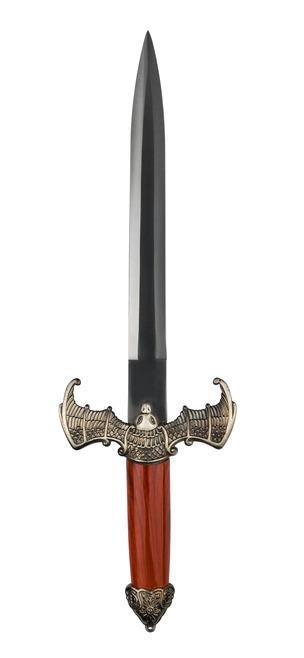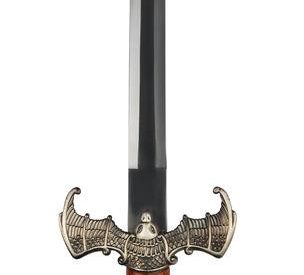Most people think of a dagger as an implement used in close combat, and a knife as a utensil or utility tool. The dagger is often referred to as a type of knife.
While they visually look similar, they are two completely different types of blades and have different functions.
Why People Get It Wrong
Some people assume that since a knife or dagger has a handle, blade, and sometimes a sheath, they can be used interchangeably. However, they both serve different purposes and are designed specifically for certain tasks.
In reality, daggers are primarily intended as a weapon. For thousands of years daggers were part of a soldier?s kit.
Knives are designed for multiple uses. Some are for personal protection, some for hunting, and others for use in the kitchen.
The Difference: The Dagger

The short, double-edged blade of a dagger is intended to inflict as much damage as possible on an enemy by using short, stabbing thrusts.
Julius Caesar?s death was one of history?s most famous incidences of using a dagger to kill. Caesar was attacked by multiple assailants using daggers to stab him 23 times.
Daggers usually have a hilt that the user grasps to prevent self-inflicted injuries when handling the weapon. They require a sheath for safe storage. The distinctive shape is iconic and easily recognizable, due to the short blade with a sharply tapered point and a central spine with two cutting edges.
The Difference: The Knife
Knives are primarily task oriented. They are used by hunters and others when hiking, fishing, camping, or hunting. They can also be used by the military as a weapon of last resort.
Knives are used for cutting or slashing. They come with a fixed blade, or the blade can be folded into a sheath.
Personal preference, cost, and purpose determine which knife blade you choose, whereas a dagger has only one real purpose.
History of the Dagger
Daggers originated in prehistoric times where they functioned as both tools and hunting weapons. Early daggers were made of flint, ivory, or bone. Copper daggers first appeared in the Bronze Age, about 5000 years ago in Egypt.
Egyptian Royalty carried gold daggers as a symbol of their status. The weapons evolved over time to symbolize wealth, and were decorated with gems and precious stones.
Eventually, once guns took the place of edged weapons, daggers became largely ceremonial.
However, some militaries and individual soldiers still favor the dagger. During World War I, for example, daggers were used for close combat fighting in trench warfare. They were also popular weapons used by some American soldiers during the Vietnam War.
History of the Knife
The knife was humankind?s first tool and, similar to the dagger, was originally made of rock, flint, bone, and obsidian. Again, like daggers, knife manufacturers eventually started using more durable materials such as titanium, steel, iron, bronze, and copper.
Most knives are either fixed blade or folding. There are many variations of a knife, and it can be used from everything from a utensil in the home to a combat weapon such as a tactical or throwing knife.
The knife is also a ritual or spiritual symbol to many cultures. Many religions use a specially sanctified or blessed type of knife to perform ceremonial sacrifices of animals ? and even humans ? up until modern times.
Side-by-Side Comparison: The Dagger
The dagger?s structure and integrity are much stronger than that of the knife?s. Structurally, the dagger possesses a more durable blade with sharp edges on both sides to aid in the stabbing movement when attacking an enemy.
The dagger was primarily used as a close combat weapon. This meant the dagger needed a stronger structure to withstand the stresses of close contact fighting. The dagger?s purpose speaks to why it has two sharp edges. It allows for the most amount of damage to be dealt on the opponent or victim.
Daggers are much heavier than knives. They need the extra weight because of the physics involved in the thrusting movement. If the dagger is not heavy enough, there is not enough force behind the weapon to allow it to penetrate. The extra weight also reinforces the dagger?s structure and durability. Daggers typically weigh over one pound.
A dagger?s length ranges anywhere between five to twelve inches long. A longer dagger is heavier and inflicts more damage to the victim.
Side-by-Side Comparison: The Knife
Knives have a much smaller structure than daggers. The knife typically has one sharp edge and comes in a variety of different sizes and styles. These include fixed blades, folding, and assisted. Assisted knives open with a spring by pressing a button or moving a latch up or down. Switchblades work this way. Some assisted knives work by flicking them open with a flick of your wrist. These sorts of blades are called butterfly knives.
Knives can serve a wide variety of purposes. Some are used in a tactical/survival setting. Others, like the famous Swiss Army Knife, have more than just a blade. They can have a fold-out screwdriver, bottle opener, tweezers, scissors, file, and more.
Knives typically weigh less than a pound. Knives are lightweight because they are intended for compact storage and easy access. Folding knives are lighter than some fixed blade knives. Multipurpose knives are heavier because of the number of tools included.
Knives differ in length. Like the dagger, the length is dependent on the purpose, material, and type. Tactical or survival knives come in longer lengths than the folding knives. Folding knife styles typically come in smaller blade lengths in order to allow for storage space.
Conclusion
Modern warfare has made the dagger obsolete except for ceremonial occasions. However, daggers remain popular among certain combat specialists and as personal protection items.
Knives are utilitarian and are used around the house, for outdoor activities such as camping, and in modern combat.
Each type of blade enjoys a rich history and remains popular as a collector?s item.


